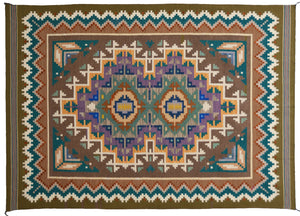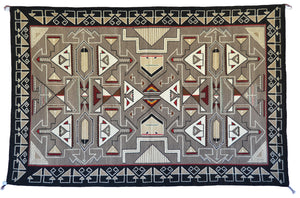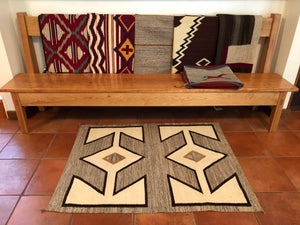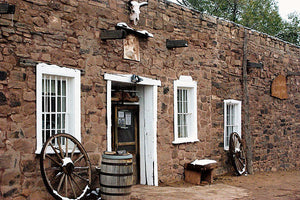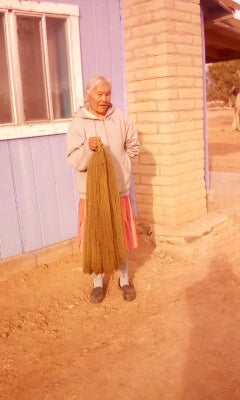Natural Dyes - Old Traditions Dye Hard, for that we thank you!

Natural Beauties
Navajo's use of natural dyes has a long history. Some scholars believe Navajo weavers began using natural materials to dye their wool as far back as the 1700s. We agree!
Let's start with Indigo blue. Indigo dye is made from Indigofera Tinctoria plant that grows in Mexico, Central and South America. Mexico grew and processed the Indigo plants into a dye powder.
 Indigofera Tinctoria
Indigofera TinctoriaThe dye became a popular export from Mexico. The Old Spanish Trail - sometimes referred to as the Indigo Trail - begins in what is now Mexico City and goes all the way to Taos, New Mexico. In the 1700s Mexican traders worked all the way up and down the trail, bringing Indigo to the Navajo weavers. Natural Indigo is still use today!

Indigo Blue, (Photo Credit: Isabella Whitworth)
On to Cochineal dye. Cochineal dye has and interesting history. It starts with a tiny insect named Cochineal and the Prickly Pear Cactus. The insect lives on the pads of the cactus. The insects are brushed from the cactus, sun dried and ground into a dye powder. The dye creates beautiful deep scarlet, red and purple hues. During the Aztec Empire, Cochineal became Mexico's second-most valued export, second only to silver. When the Spanish arrived in 1519 they were impressed and intrigued with the Aztec's use brightly colored clothes.
 Prickly Pear Cactus infested with Cochineal,
Prickly Pear Cactus infested with Cochineal, (Photo credit: Tucson Cactus and Succulent Society)
In Europe at that time purple and scarlet red fabric was so outrageously expensive that only rulers could afford it. The dye initially used to make purple, came from the Phoenician trading city of Tyre, which is now in modern-day Lebanon. Fabric traders obtained the dye from a small mollusk that was only found in the Tyre region of the Mediterranean Sea.
After the Spanish conquered the Aztec Empire, they began to export Cochineal dye to Europe. The dye was consumed throughout Europe and was so highly prized, at one point is was more valuable than gold. Fun Fact: because purple was so closely linked to power, wealth and royalty, Queen Elizabeth the first forbade anyone except close members of the royal family to wear purple.
Due to Cochineal's value, very little made it's way up the Spanish Trail. Because of that weavings with Cochineal dyed wool is very rare. Most weavings with red made in the 1800s is made with Cochineal dyed Spanish Bayetta. Bayetta cloth was made in England for the Spanish traders. The cloth made its way back to the US where it was distributed to the Navajo. The weavers liked the red so much they would painstakingly unravel the cloth and incorporate it into their weavings. Today our weavers use Churro wool dyed with Cochineal, which creates absolutely beautiful weavings.

Cochineal dyed wool

Cochineal dyed wool
You may be surprised to know Cochineal is used for more than just fabric dye. Get ready, Cochineal, also known as carmine, or Natural Red 4 is used in the food industry, cosmetic industry and even in pharmaceuticals. Yikes! So, if insects in your food is just not your thing, read the label!
A bit of dark, however important, history which backs up our belief that early Navajo weavers used natural dyes in the 1700s .


Massacre Cave, Canyon Del Muerto, Cayon De Chelly
In the late 1700s the Navajo were at war with neighboring tribes and the Spanish Colonist in the Rio Grand Valley. Spain dispatched a punitive expedition to the Navajo stronghold of Canyon De Chelly. This punitive expedition was sent to punish the Navajo in the worst way.
In the late 1700s the Navajo were at war with neighboring tribes and the Spanish Colonist in the Rio Grand Valley. Spain dispatched a punitive expedition to the Navajo stronghold of Canyon De Chelly. This punitive expedition was sent to punish the Navajo in the worst way.
When the Navajo heard the Spanish expedition was on the way, most fled the canyon. Yet a group stayed behind. The women, children and the elderly in the group were hidden in a cave high above the canyon floor. The men waited in the canyon for the expedition to pass. The story is one of the women in the cave, thinking they were safe from harm, yelled at the Spanish expedition as they rode by, blowing their cover in the cave.
The Spanish opened fire on the cave killing many inside. The survivors didn't last long as the Spanish troops found their way into the cave killing the remaining Navajo. Spanish documents report that over 115 Navajo were killed that day - the women, children and elderly in the group.
Superstitions kept the cave untouched for 100 years until a trader by the name of Sam Day explored the cave. He found one complete blanket and fragments of clothing and blankets inside the cave along with skeletons of the inhabitants. Marks of the bullets left on the cave ceiling can still be seen today. Since that time the cave has been known as Massacre Cave.
Day retrieved the blankets and sold them to museums around the U.S. Those blankets are believed to the oldest Navajo blankets in existence. Below is one of the blankets, which has wool dyed with Cochineal!

One of the oldest surviving Navajo blankets (circa 1800) from Massacre Cave in Canyon DeChelly, (Photo credit: Art Quil)
Below are a few weavings available with natural dyed Indigo and Cochineal.
This small Navajo weaving is extremely special, circa 1865. Woven for a baby in the classic period. It is finely woven with white and Indigo dyed home spun wool, 2 shades of red Cochineal Bayatta and light peach Cochineal Bayetta.

1st Phase Chief Blanket, Churro # 1569
Navajo weaver Judy Marianito just finished (2018) this unique 1st Phase Chief Blanket. It is woven like a classic Chief Blanket, it has the handle of a true blanket weave. Narrow Cochineal red and Indigo blue stripes are highlighted with a thick black band. The ivory banding adds to the over all effect. Truly special.

1st Phase Chief Blanket, Churro # 1569
Navajo weaver Judy Marianito just finished (2018) this unique 1st Phase Chief Blanket. It is woven like a classic Chief Blanket, it has the handle of a true blanket weave. Narrow Cochineal red and Indigo blue stripes are highlighted with a thick black band. The ivory banding adds to the over all effect. Truly special.
Questions, comments? We would love to talk with you! Give us a call at the gallery 520-455-5020.
- Beth Barth


